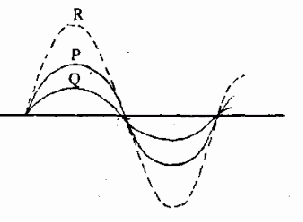The sound intensity – measured in![]() - is the amount of energy that a sound wave brings to an area every second. The sound intensity depends on the amplitude, so that a more intense or louder wave must have a larger amplitude. The relationship between intensity and amplitude is not linear – intensity varies as the square of the intensity:
- is the amount of energy that a sound wave brings to an area every second. The sound intensity depends on the amplitude, so that a more intense or louder wave must have a larger amplitude. The relationship between intensity and amplitude is not linear – intensity varies as the square of the intensity:
![]()
This relationship is true for all waves, regardless of any other factors – e.g. frequency. (In fact, intensity has the same relation to frequency:![]() ).
).
It must be noted that intensity is not proportional to the area under a displacement time graph. This is illustrated below for two waveforms of equal wavelength and frequency. If the maximum displacement is doubled, from P to R, the intensity increases by 4, but the area only doubles. If the maximum displacement is tripled, from Q to R, the intensity increases by 9, but the area only triples.

Intensity obeys an inverse square law:![]() if there are no obstacles or interference. Sound waves don't typically carry a great deal of energy – typically the power of a sound wave is a few watts, and the inverse square law means the intensity falls of rapidly with distance but because the threshold of intensity for a sound to be heard is only about
if there are no obstacles or interference. Sound waves don't typically carry a great deal of energy – typically the power of a sound wave is a few watts, and the inverse square law means the intensity falls of rapidly with distance but because the threshold of intensity for a sound to be heard is only about![]() it can still be heard at surprsingly large distances.
it can still be heard at surprsingly large distances.
